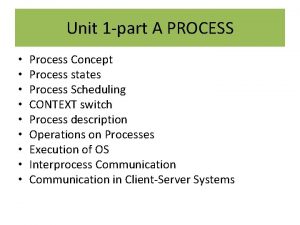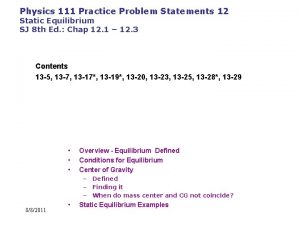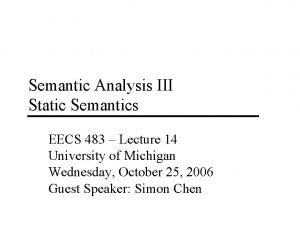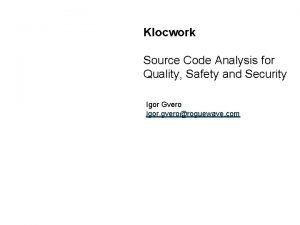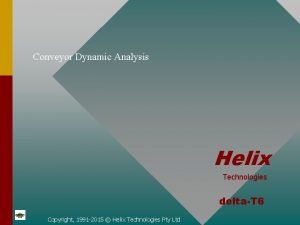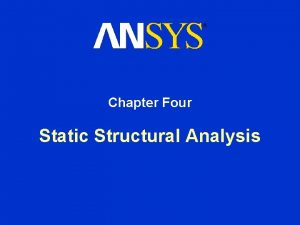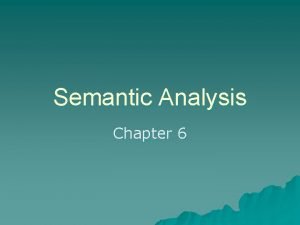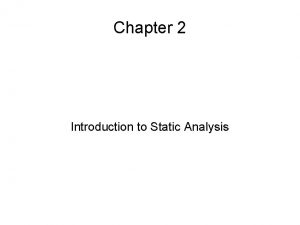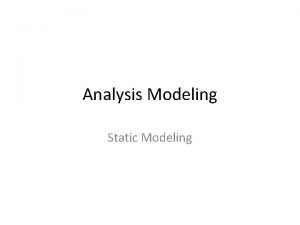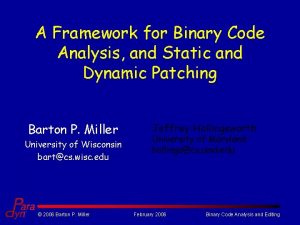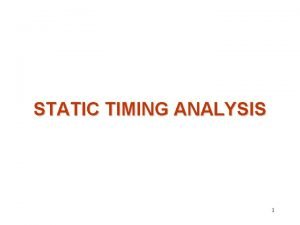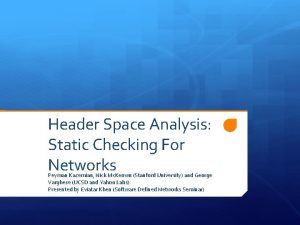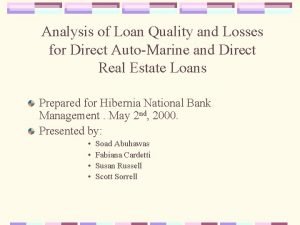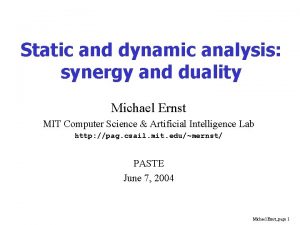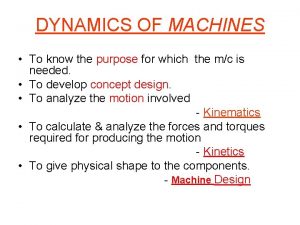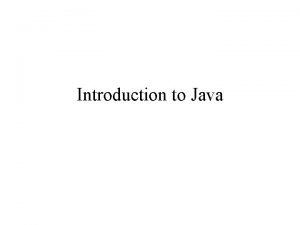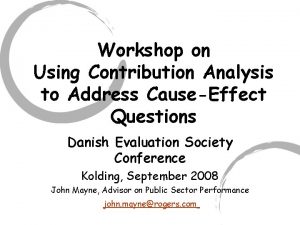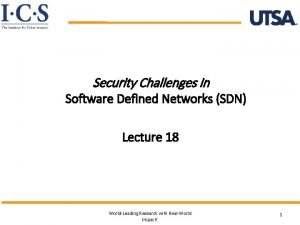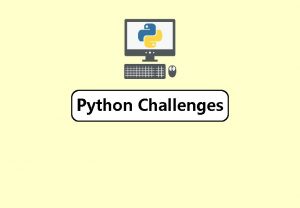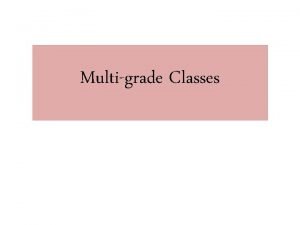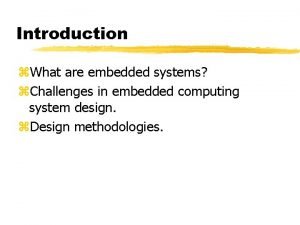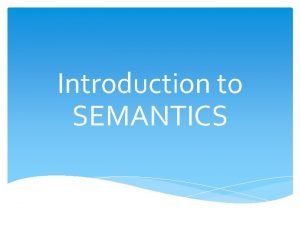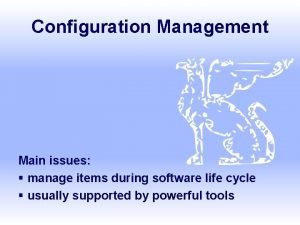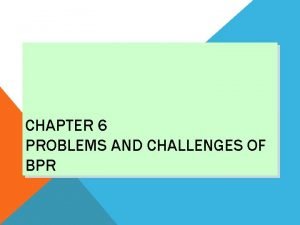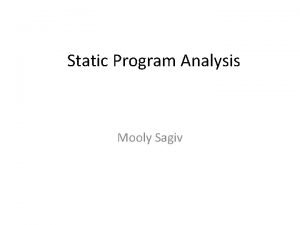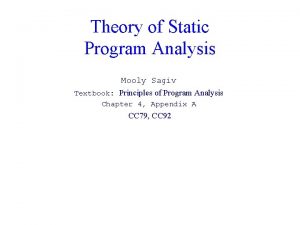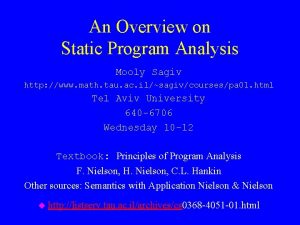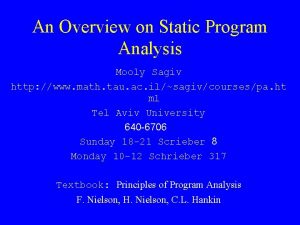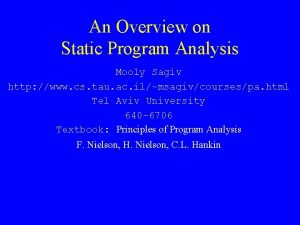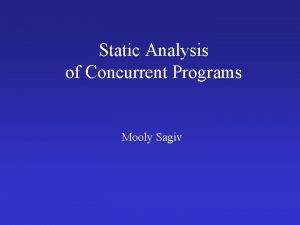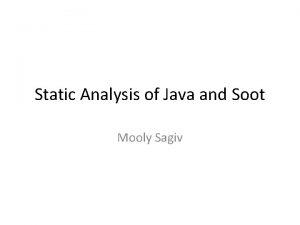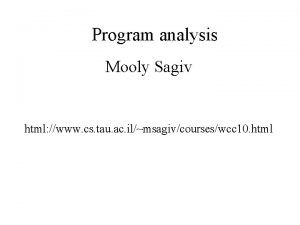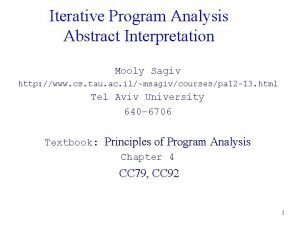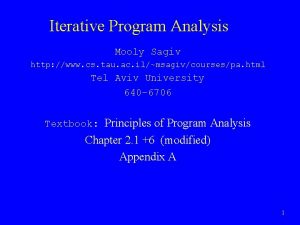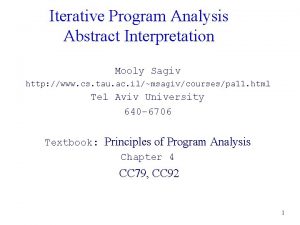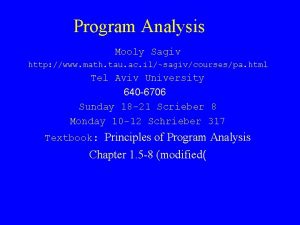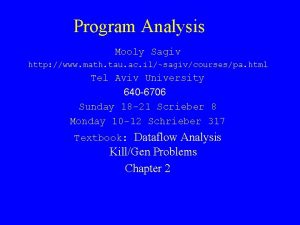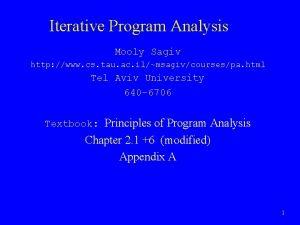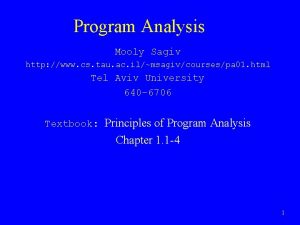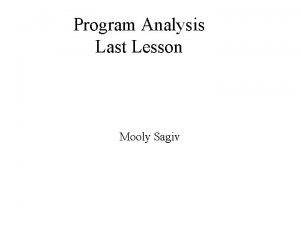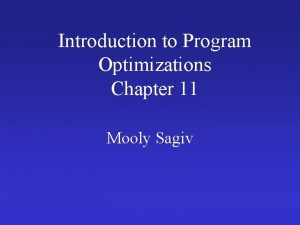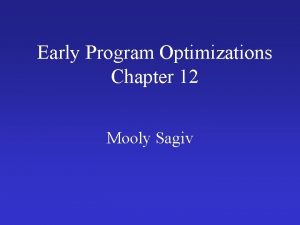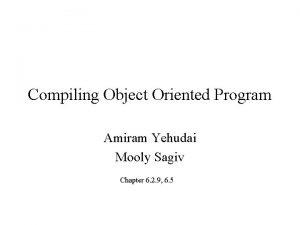Introduction to Static Program Analysis Mooly Sagiv Challenges



![Simple Correct C code main() { int i = 0, *p =NULL, a[100]; for Simple Correct C code main() { int i = 0, *p =NULL, a[100]; for](https://slidetodoc.com/presentation_image_h2/94ef4c4de9677e0fc2edc9880f8d6735/image-4.jpg)
![Simple Correct C code main() { int i = 0, *p=NULL, a[100]; for (i=0 Simple Correct C code main() { int i = 0, *p=NULL, a[100]; for (i=0](https://slidetodoc.com/presentation_image_h2/94ef4c4de9677e0fc2edc9880f8d6735/image-5.jpg)
![Simple Incorrect C code main() { int i = 0, *p=NULL, a[100], j; for Simple Incorrect C code main() { int i = 0, *p=NULL, a[100], j; for](https://slidetodoc.com/presentation_image_h2/94ef4c4de9677e0fc2edc9880f8d6735/image-6.jpg)




















![Simple Correct C code main() { int i = 0, a[100]; { [-minint, maxint] Simple Correct C code main() { int i = 0, a[100]; { [-minint, maxint]](https://slidetodoc.com/presentation_image_h2/94ef4c4de9677e0fc2edc9880f8d6735/image-27.jpg)
![The Power of Interval Analysis int f(x) { {[minint , maxint]} if (x > The Power of Interval Analysis int f(x) { {[minint , maxint]} if (x >](https://slidetodoc.com/presentation_image_h2/94ef4c4de9677e0fc2edc9880f8d6735/image-28.jpg)




![Collecting Semantics (Example) n 1 CS[n 1] =Z assume x>1000 CS[n 2] = x Collecting Semantics (Example) n 1 CS[n 1] =Z assume x>1000 CS[n 2] = x](https://slidetodoc.com/presentation_image_h2/94ef4c4de9677e0fc2edc9880f8d6735/image-33.jpg)




![Abstract Interpretation of Atomic Statements #[l, u] = [l, u] �skip� #[l, u] = Abstract Interpretation of Atomic Statements #[l, u] = [l, u] �skip� #[l, u] =](https://slidetodoc.com/presentation_image_h2/94ef4c4de9677e0fc2edc9880f8d6735/image-38.jpg)
![Interval Analysis n 1 DF[n 1] =[- , ] DF[n 2] = x : Interval Analysis n 1 DF[n 1] =[- , ] DF[n 2] = x :](https://slidetodoc.com/presentation_image_h2/94ef4c4de9677e0fc2edc9880f8d6735/image-39.jpg)





![Iterations Interval Analysis n 1 x : =x+1 N DF[n 1] [- , ] Iterations Interval Analysis n 1 x : =x+1 N DF[n 1] [- , ]](https://slidetodoc.com/presentation_image_h2/94ef4c4de9677e0fc2edc9880f8d6735/image-45.jpg)





![Widening for Interval Analysis • [c, d] = [c, d] • [a, b] [c, Widening for Interval Analysis • [c, d] = [c, d] • [a, b] [c,](https://slidetodoc.com/presentation_image_h2/94ef4c4de9677e0fc2edc9880f8d6735/image-51.jpg)
![Iterations Interval Analysis with widening DF[n 1] =[- , ] DF[n 2] = DF[n Iterations Interval Analysis with widening DF[n 1] =[- , ] DF[n 2] = DF[n](https://slidetodoc.com/presentation_image_h2/94ef4c4de9677e0fc2edc9880f8d6735/image-52.jpg)


![Narrowing for Interval Analysis • [a, b] = [a, b] • [a, b] [c, Narrowing for Interval Analysis • [a, b] = [a, b] • [a, b] [c,](https://slidetodoc.com/presentation_image_h2/94ef4c4de9677e0fc2edc9880f8d6735/image-55.jpg)
![Iterations with narrowing after widening DF[n 1] =[- , ] DF[n 2] = DF[n Iterations with narrowing after widening DF[n 1] =[- , ] DF[n 2] = DF[n](https://slidetodoc.com/presentation_image_h2/94ef4c4de9677e0fc2edc9880f8d6735/image-56.jpg)


![Collecting Semantics for Pointers State 1= [Loc Z] Collecting Semantics for Pointers State 1= [Loc Z]](https://slidetodoc.com/presentation_image_h2/94ef4c4de9677e0fc2edc9880f8d6735/image-59.jpg)














- Slides: 73

Introduction to Static Program Analysis Mooly Sagiv

Challenges in Proving Correctness • Specifying what the program is supposed to do • Writing loop invariants • Decision procedures for proving implications – Deduction

Static Analysis • Automatically infer sound invariants from the code • Prove the absence of certain program errors • Prove user-defined assertions • Report bugs before the program is executed
![Simple Correct C code main int i 0 p NULL a100 for Simple Correct C code main() { int i = 0, *p =NULL, a[100]; for](https://slidetodoc.com/presentation_image_h2/94ef4c4de9677e0fc2edc9880f8d6735/image-4.jpg)
Simple Correct C code main() { int i = 0, *p =NULL, a[100]; for (i=0 ; i <100, i++) { a[i] = i; p = malloc(1, sizeof(int)); *p = i; free(p); // not alloc(p) p = NULL; // no leak }
![Simple Correct C code main int i 0 pNULL a100 for i0 Simple Correct C code main() { int i = 0, *p=NULL, a[100]; for (i=0](https://slidetodoc.com/presentation_image_h2/94ef4c4de9677e0fc2edc9880f8d6735/image-5.jpg)
Simple Correct C code main() { int i = 0, *p=NULL, a[100]; for (i=0 ; i <100, i++) { { 0 <= i < 100} a[i] = i; { p == NULL: } p = malloc(1, sizeof(int)); { alloc(p) } *p = i; {alloc(p)} free(p); {!alloc(p)} p = NULL; {p==NULL} }
![Simple Incorrect C code main int i 0 pNULL a100 j for Simple Incorrect C code main() { int i = 0, *p=NULL, a[100], j; for](https://slidetodoc.com/presentation_image_h2/94ef4c4de9677e0fc2edc9880f8d6735/image-6.jpg)
Simple Incorrect C code main() { int i = 0, *p=NULL, a[100], j; for (i=0 ; i <j , i++) { { 0 <= i < j} a[i] = i; p = malloc(1, sizeof(int)); { alloc(p) } free(p); }

Sound (Incomplete) Static Analysis • It is undecidable to prove interesting program properties • Focus on sound program analysis – When the compiler reports that the program is correct it is indeed correct for every run – The compiler may report spurious (false alarms)

A Simple False Alarm int i, *p=NULL; … if (i >=5) { p = malloc(1, sizeof(int)); } … if (i >=5) { *p = 8; } … if (i >=5) { free(p); }

A Complicated False Alarm int i, *p=NULL; … if (foo(i)) { p = malloc(1, sizeof(int)); } … if (bar(i )) { *p = 8; } … if (zoo(i)) { free(p); }

Foundation of Static Analysis • Static analysis can be viewed as interpreting the program over an “abstract domain” • Execute the program over larger set of execution paths • Guarantee sound results – Whenever the analysis reports that an invariant holds it indeed hold

Even/Odd Abstract Interpretation • Determine if an integer variable is even or odd at a given program point

Example Program /* x=? */ while (x !=1) do { /* x=? */ if (x %2) == 0 /* x=? */ { x : = x / 2; } /* x=E */ else { x : = x * 3 + 1; /* x=O */ assert (x %2 ==0); } /* x=E */ } /* x=O*/

Lattice of Values ? O E

Abstract Interpretation Concrete Sets of stores Abstract Descriptors of sets of stores

Odd/Even Abstract Interpretation All concrete states {x: x Even} {0, 2} {0} ? {-2, 1, 5} {2} E O

Odd/Even Abstract Interpretation All concrete states {x: x Even}{-2, 1, 5} {0, 2} {0} {2} ? E O

Odd/Even Abstract Interpretation All concrete states {x: x Even}{-2, 1, 5} {0, 2} {0} {2} ? E O

Example Program while (x !=1) do { if (x %2) == 0 { x : = x / 2; } else /* x=E */ /* x=O */ { x : = x * 3 + 1; assert (x %2 ==0); } }

(Best) Abstract Transformer Operational Semantics Concrete Representation St Concretization Abstract Representation Concrete Representation Abstraction St Abstract Semantics Abstract Representation

(Best) Abstract Transformer x : = 3*x + 1 Concrete Representation St Concretization Abstract Representation Concrete Representation Abstraction x : = St 3*x + 1 x : = if x = then else if x = ? then ? else if x =O then E else O Abstract Representation

(Best) Abstract Transformer x : = 3*x + 1 - , …, -1, 0, 1, 2 …, St - , …, -2, 1, 7, …, Concretization Abstraction ? x : = St 3*x + 1 x : = if x = then else if x = ? then ? else if x =O then E else O ?

(Best) Abstract Transformer x : = 3*x + 1 - , …, -2 , 0, 2, 4 …, St - , …, -5, 1, 7, …, Concretization Abstraction E x : = St 3*x + 1 x : = if x = then else if x = ? then ? else if x =O then E else O O

(Best) Abstract Transformer x : = 3*x + 1 - , …, -1 , 1, 3 …, St - , …, -2, 4, 10, , Concretization Abstraction O x : = St 3*x + 1 x : = if x = then else if x = ? then ? else if x =O then E else O E

Runtime vs. Static Testing Effectiveness Runtime Static Analysis Missed Errors False alarms Locate rare errors Cost Proportional to program’s execution Proportional to program’s size No need to efficiently handle rare cases Can handle limited classes of programs and still be useful

Static Analysis Algorithms • Generate a control flow graph • Collecting semantics define the reachable states • Generate a system of equations over the abstract values at every node • Iteratively compute the simultaneous least solution at every node • The solution is guaranteed to be sound – Abstracts the set of reachable states – Computes an inductive invariant • May not be strong enough • The correctness of the safety properties can be conservatively checked

Example Interval Analysis • Find a lower and an upper bound of the value of a single variable • Can be generalized to multiple variables
![Simple Correct C code main int i 0 a100 minint maxint Simple Correct C code main() { int i = 0, a[100]; { [-minint, maxint]](https://slidetodoc.com/presentation_image_h2/94ef4c4de9677e0fc2edc9880f8d6735/image-27.jpg)
Simple Correct C code main() { int i = 0, a[100]; { [-minint, maxint] } for (i=0 ; i <100, i++) { {[0, 99]} a[i] = i; {[0, 99]} } {[100, 100]}
![The Power of Interval Analysis int fx minint maxint if x The Power of Interval Analysis int f(x) { {[minint , maxint]} if (x >](https://slidetodoc.com/presentation_image_h2/94ef4c4de9677e0fc2edc9880f8d6735/image-28.jpg)
The Power of Interval Analysis int f(x) { {[minint , maxint]} if (x > 100) { {[101, maxint]} return x -10 ; {[91, maxint-10]; } } else { {[minint, 100] } return f(f(x+11)) { [91, 91]} }

Example Program Interval Analysis n 1 x : = 1 ; while x 1000 do x : = x + 1; x : =1 n 2 x : =x+1 assume x>1000 assume x 1000 n 3 n 4

Example Program Interval Analysis x : = 1 ; while x x : =1 1000 do [1, 1001] x : = x + 1; [- , ] n 1 n 2 x : =x+1 [1, 1000] assume x>1000 [1001, 1001] n 4 assume x 1000 n 3

Collecting Interpretation • Defines the set of reachable states as the least solution to a systems of equations • Uniquely defined • But not necessarily computable

Collecting Semantics (Example) - , …, -1, 0, 1, n 1 x : =1 1001 1, 2, …, 1001 assume x>1000 n 2 n 4 x : =x+1 1, 2, …, 1000 assume x 1000 n 3
![Collecting Semantics Example n 1 CSn 1 Z assume x1000 CSn 2 x Collecting Semantics (Example) n 1 CS[n 1] =Z assume x>1000 CS[n 2] = x](https://slidetodoc.com/presentation_image_h2/94ef4c4de9677e0fc2edc9880f8d6735/image-33.jpg)
Collecting Semantics (Example) n 1 CS[n 1] =Z assume x>1000 CS[n 2] = x : = 1 CS[n 1] n 2 n 4 x : = x+1 assume x 1000 CS[n 3] = assume x 1000 3] 2] x>1000 CS[n 4] = CS[n assume n 3 CS[n ] x : =1 x : =x+1 2 : 2 Z 2 Z CS[n 1] x : = 1 = w. {1} Z x : = x+1 = w. {z+1 | z w Z } assume x>100 = w. Z assume x 100 = w. CS[n 2] CS[n 3] CS[n 4] {x |1 x 1001} {x |1 x 1000} {x |1 x 1001} {1002} {x |x 1000} {x |x 1001} {1001]

The Lattice of Intervals -

Galois Connection

Abstract Interpretation of Joins then l 1 else u 1 l 2 u 2 �� min l 1, l 2 max u 1, u 2 [l 1, u 1] �[l 2, u 2] =[min(l 1, l 2), max (u 1, u 2)]

Abstract Interpretation of Meets assume l 1 assume u 1 l 2 u 2 � max l 1, l 2 min u 1, u 2 [l 1, u 1] �[l 2, u 2] =[max(l 1, l 2), min (u 1, u 2)]
![Abstract Interpretation of Atomic Statements l u l u skip l u Abstract Interpretation of Atomic Statements #[l, u] = [l, u] �skip� #[l, u] =](https://slidetodoc.com/presentation_image_h2/94ef4c4de9677e0fc2edc9880f8d6735/image-38.jpg)
Abstract Interpretation of Atomic Statements #[l, u] = [l, u] �skip� #[l, u] = [1, 1] � x : = 1� #[l, u] = [l, u] + [1, 1] = [l + 1, u + 1] x : = x + 1� #[l, u] = assume x k�
![Interval Analysis n 1 DFn 1 DFn 2 x Interval Analysis n 1 DF[n 1] =[- , ] DF[n 2] = x :](https://slidetodoc.com/presentation_image_h2/94ef4c4de9677e0fc2edc9880f8d6735/image-39.jpg)
Interval Analysis n 1 DF[n 1] =[- , ] DF[n 2] = x : = assume x>1000 n 2 n 4 1 #DF[n 1] assume x 1000 # x : =x+1 xx 100 : = x+1 DF[n 3] = assume # DF[n 3] 2] x>100 DF[n 4] = assume # n 3 DF[n 2] #: Z Z DF[n 1] DF[n 2] DF[n 3] DF[n 4] x : = 1 #= w. [1, 1] [- , ] [1, 1001] [1, 1000] [1001, 1001] x : = x+1 #= [l, u]. [l+1, [- , ] [1, 1000] [1, 1001] {1002} # u+1] assume x>100 = w. x : =1 assume x 100 #= w. Z [x |x 1000] {x |x 1001} {1001]

Solving the Equations • For programs with loops the equations have many solutions • Every solution is sound • Compute a minimal solution

An Example with Multiple Solutions n 1 x: =1 n 2 skip DF(n 1) = [- , ] DF(n 2) = x: =1 # DF(n 1) skip # DF(n 3) = skip # DF(n 2) n 3 DF[n 1] DF[n 2] DF[n 3] Comments [- , ] Maximal [- , ] [1, 1] Minimal [- , ] [1, 2] Solution [- , ] [1, 1] [1, 2] Not a solution

Computing Minimal Solution • Initialize the interval at the entry according to program semantics • Initialize the rest of the intervals to empty • Iterate until no more changes

Iterations Interval Analysis n 1 x : =1 n 2 x : =x+1 assume x>1000 n 4 assume x 1000 N n 3 DF[n 1] [- , ] DF[n 2] � DF[n 3] � n 1 n 2 [1, 1] n 3 n 2 n 3 [1, 1] [1, 2] DF[n 4] �

Iterative Algorithm Chaotic(G(V, E): Graph, s: Node, L: Lattice, : L, f: E (L L) ){ for each v in V to n do DF[v] : = df[v] = WL = {s} while (WL ) do select and remove an element u WL for each v, such that. (u, v) E do temp = f(e)(DF[u]) new : = DF[v] temp if (new DF[V]) then DF[v] : = new; WL : = WL {v}
![Iterations Interval Analysis n 1 x x1 N DFn 1 Iterations Interval Analysis n 1 x : =x+1 N DF[n 1] [- , ]](https://slidetodoc.com/presentation_image_h2/94ef4c4de9677e0fc2edc9880f8d6735/image-45.jpg)
Iterations Interval Analysis n 1 x : =x+1 N DF[n 1] [- , ] DF[n 2 DF[n 3] DF[n ] 4] � � � WL {n 1, n 2, n 3, n 4} n 1 n 2 [1, 1] n 3 n 2 n 3 {n 2, n 3, n 4} [1, 1] [1, 2] {n 2, n 4} {n 3, n 4} [1, 2] {n 2, n 4} assume x>1000 n 2 n 4 assume x 1000 n 3

Fixed Points f( ) f 2( ) • A monotone function f: L L where (L, , , ) is a complete lattice Red(f) • Fix(f) = { l: l L, f(l) = l} • Red(f) = {l: l L, f(l) l} • Ext(f) = {l: l L, l f(l)} Fix(f) gfp(f) – l 1 l 2 f(l 1 ) f(l 2 ) • Tarski’s Theorem 1955: if f is monotone then: – lfp(f) = Fix(f) = Red(f) Fix(f) – gfp(f) = Fix(f) = Ext(f) Fix(f) lfp(f) f 2( ) f( )

f#( ) a: f( (a)) (f#(a)) f 2( ) f#2( ) f(x) x f#(y) y gfp(f#) gfp(f) f(x)=x f#(y)=y lfp(f) lfp(f#) f#(y) y f( ) f#2( ) f#( ) f(x) x f 2( ) f( )

Lfp(f) f# f f# Lfp(f#) f f# Finite Height Case f

Accelerating Convergence • The Iterative algorithm can diverge when the domains contains infinite increasing chains • Sometimes can take long time

Widening • Accelerate the convergence of the iterative procedure by jumping to a more conservative solution • Heuristic in nature • But simple to implement
![Widening for Interval Analysis c d c d a b c Widening for Interval Analysis • [c, d] = [c, d] • [a, b] [c,](https://slidetodoc.com/presentation_image_h2/94ef4c4de9677e0fc2edc9880f8d6735/image-51.jpg)
Widening for Interval Analysis • [c, d] = [c, d] • [a, b] [c, d] = [ if a c then a else - , if b d then b else ]
![Iterations Interval Analysis with widening DFn 1 DFn 2 DFn Iterations Interval Analysis with widening DF[n 1] =[- , ] DF[n 2] = DF[n](https://slidetodoc.com/presentation_image_h2/94ef4c4de9677e0fc2edc9880f8d6735/image-52.jpg)
Iterations Interval Analysis with widening DF[n 1] =[- , ] DF[n 2] = DF[n 2] x : = 1 #DF[n 1] x : = x+1 # DF[n 3] n 1 x : =1 n 2 # DF[n 3] = assume x 100 DF[n 2] x>100 # DF[n 4] = assume N DF[n 2]DF[n 3] DF[n 1] DF[n 2] [- , ] � � DF[n 4] � x : =x+1 assume x 1000 WL {n 1, n 2, n 3, n 4} n 1 n 2 [1, 1] n 3 n 2 n 3 {n 2, n 3, n 4} [1, 1] [1, ] {n 2, n 4} {n 3, n 4} [1, 1000] assume x>1000 n 4 { n 4} n 3

Widening yk = yk f (yk) lfp(f) � y 2 = y 1 f (y 1) x 2= f 2( ) y 1= f( ) x 1 = f( ) x 0 =

Narrowing • Improve the precision of widened solution • Heuristic in nature • But simple to implement
![Narrowing for Interval Analysis a b a b a b c Narrowing for Interval Analysis • [a, b] = [a, b] • [a, b] [c,](https://slidetodoc.com/presentation_image_h2/94ef4c4de9677e0fc2edc9880f8d6735/image-55.jpg)
Narrowing for Interval Analysis • [a, b] = [a, b] • [a, b] [c, d] = [ if a = - then c else a, if b = then d else b ]
![Iterations with narrowing after widening DFn 1 DFn 2 DFn Iterations with narrowing after widening DF[n 1] =[- , ] DF[n 2] = DF[n](https://slidetodoc.com/presentation_image_h2/94ef4c4de9677e0fc2edc9880f8d6735/image-56.jpg)
Iterations with narrowing after widening DF[n 1] =[- , ] DF[n 2] = DF[n 2] x : = 1 #DF[n 1] x : = x+1 # DF[n 3] = assume x 100 # DF[n 2] x>100 # DF[n 4] = assume N DF[n ] DF[n 1] DF[n 2] 2 DF[n 3] DF[n 4] [- , ] n 2 n 3 [1, ] [1, 1000] [1001, ] [2, 1001] WL {n 1, n 2, n 3, n 4} { n 4} [1001, 1001] x : =1 n 2 assume x>1000 n 4 x : =x+1 assume x 1000 {n 2, n 3, n 4} [1, 1] n 1 {n 3, n 4} n 3

Numeric Abstract Domain Examples y y x y x x signs intervals octagons x 0 polyhedra x [a, b] x y c ai xi c

Pointer Language a : : = x | *x | &x | … b : : = true | a = a| not b assume b x : = a *x : = y
![Collecting Semantics for Pointers State 1 Loc Z Collecting Semantics for Pointers State 1= [Loc Z]](https://slidetodoc.com/presentation_image_h2/94ef4c4de9677e0fc2edc9880f8d6735/image-59.jpg)
Collecting Semantics for Pointers State 1= [Loc Z]

Points-To Analysis u Lattice Lpt = u Galois connection u Meaning of statements

t : = &a; y : = &b; z : = &c; if x> 0 then p: = &y; else p: = &z; *p : = t;


Abstract Transformers State#= P(Var* Var*) x : = a # x : = &y # x : = *y # x : = y # *x : = y # assume x ==y # assume x !=y #


Flow insensitive points-to-analysis Steengard 1996 u Ignore control flow u One set of points-to per program u Can be represented as a directed graph u Conservative approximation – Accumulate pointers u Can be computed in almost linear time – Union find


Precision u We cannot usually have – (CS) = DF on all programs u But can we say something about precision in all programs?

The Join-Over-All-Paths (JOP) u Let paths(v) denote the potentially infinite set paths from start to v (written as sequences of edges) u For a sequence of edges [e 1, e 2, …, en] define f #[e 1, e 2, …, en]: L L by composing the effects of basic blocks f #[e 1, e 2, …, en](l) = f#(en) (… (f#(e 2) (f#(e 1) (l)) …) u JOP[v] = {f#[e 1, e 2, …, en]( ) [e 1, e 2, …, en] paths(v)}

JOP vs. Least Solution u The df solution obtained by Chaotic iteration satisfies for every v: – JOP[v] df[v] u A function f# is additive (distributive) if – f#( {x| x X}) = {f#(x) | X} u If every f# (u, v) is additive (distributive) for all the edges (u, v) – JOP[v] = df[v] u Examples – Intervals – Points-to

Notions of precision = (df) u (CS) = df u Meet(Join) over all paths u Using best transformers u Good enough u CS

Complexity of Chaotic Iterations u Usually depends on the height of the lattice u In some cases better bound exist u A function f is fast if f (f(l)) l f(l) u For fast functions the Chaotic iterations can be implemented in O(nest * |V|) iterations – nest is the number of nested loop – |V| is the number of control flow nodes

Success Stories Abstract Interpretation u SLAM: Microsoft Device Driver Verification u The Astrée Static Analyzer u Panaya Change Impact Analysis

Conclusion u Static analysis is powerful technique u But expensive – More efficient methods exist for structured programs u Abstract interpretation relates runtime semantics and static information u The concrete semantics serves as a tool in designing abstractions
 Mooly sagiv
Mooly sagiv Cuckoo malware analysis
Cuckoo malware analysis Challenges of job analysis
Challenges of job analysis What is process concept
What is process concept Introduction to static equilibrium mastering physics
Introduction to static equilibrium mastering physics Eecs 483
Eecs 483 Klocwork static analysis
Klocwork static analysis Helix chip conveyor
Helix chip conveyor Static structural analysis
Static structural analysis Static semantic analysis
Static semantic analysis Limitations of static analysis
Limitations of static analysis Static requirements analysis
Static requirements analysis Binary code analyzer
Binary code analyzer Tom spyrou
Tom spyrou Header space analysis: static checking for networks
Header space analysis: static checking for networks Static pool analysis
Static pool analysis Basic dynamic analysis
Basic dynamic analysis Difference between static and dynamic analysis
Difference between static and dynamic analysis Static force analysis
Static force analysis Differences between sequential and event-driven programming
Differences between sequential and event-driven programming Perangkat lunak computer dinamakan …
Perangkat lunak computer dinamakan … Menyusun program tahunan dan program semester
Menyusun program tahunan dan program semester Microsoft excel merupakan program aplikasi… *
Microsoft excel merupakan program aplikasi… * Microsoft excel program pengolah
Microsoft excel program pengolah Ms word
Ms word Program introduction example
Program introduction example Intro paragraph outline
Intro paragraph outline Mars exploration program analysis group
Mars exploration program analysis group Nsa cyber security internship
Nsa cyber security internship Program contribution analysis
Program contribution analysis Bsa program hazard analysis
Bsa program hazard analysis War at home vs war abroad madison
War at home vs war abroad madison Toward civil war lesson 3 secession and war
Toward civil war lesson 3 secession and war Topic 7 economic performance and challenges
Topic 7 economic performance and challenges Eva tse netflix
Eva tse netflix Challenges of being a disciple in the modern world
Challenges of being a disciple in the modern world The challenges of middle and late adolescence
The challenges of middle and late adolescence Achievement of mkukuta
Achievement of mkukuta Meaning of semantics
Meaning of semantics Sdn security challenges and solutions
Sdn security challenges and solutions Software quality assurance challenges
Software quality assurance challenges Python challenge 27
Python challenge 27 Adaptive challenges examples
Adaptive challenges examples How to show challenges in ppt
How to show challenges in ppt Informational opportunities
Informational opportunities Unexpected challenges 1995
Unexpected challenges 1995 What is multigrade
What is multigrade Challenges of investigative reporting in kenya
Challenges of investigative reporting in kenya Challenges in embedded computing system design
Challenges in embedded computing system design John i saeed
John i saeed Challenges of international business
Challenges of international business Taha hussein challenges
Taha hussein challenges Challenges facing global managers
Challenges facing global managers George washingtons challenges
George washingtons challenges Emerging issues in industrial relations
Emerging issues in industrial relations Challenges of novel drug delivery system
Challenges of novel drug delivery system What are contemporary management issues
What are contemporary management issues Configuration management challenges
Configuration management challenges Configuration management challenges
Configuration management challenges Challenges in network forensics
Challenges in network forensics The land fatma omara
The land fatma omara Global management information system
Global management information system Challenges of service innovation and design
Challenges of service innovation and design What are the challenges of adolescence
What are the challenges of adolescence Challenges of bpr
Challenges of bpr Initiating camaraderie and smooth relationship
Initiating camaraderie and smooth relationship Chapter 38 challenges to the postwar order
Chapter 38 challenges to the postwar order Chapter 36 patients with special challenges
Chapter 36 patients with special challenges Diversity and regulatory challenges
Diversity and regulatory challenges Global sourcing in international business
Global sourcing in international business Rdlm society logo
Rdlm society logo Android app monetizing strategies
Android app monetizing strategies Traditional career
Traditional career Future of ihrm
Future of ihrm



